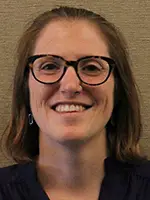
Panel discussion – Calf barns: The decision-making adventures of bringing calves inside – Fischer-Clark Dairy, River Crest Dairy, LLC, & Ocooch Dairy
By Jenna Hurty-Person, Progressive Dairyman
Building a new calf barn and completely rethinking how to raise calves effectively and efficiently can be a daunting task. At Vita Plus Calf Summit, three Wisconsin dairywomen shared their experiences as they tackled this challenge on their farms.
 Heidi Fischer
Heidi Fischer
Fischer-Clark Dairy, Inc.
Hatley, Wisconsin
In 1972, Heidi Fischer’s father-in-law started Fischer-Clark Dairy with 12 acres and 8 cows in a tie stall barn. Today, Fischer and her husband work full-time for the now 800-cow, 2,100-acre operation and are helping her in-laws expand it to 1,000 cows.
To assist with this, the farm built a new 128-pen, naturally-ventilated calf barn capable of individually housing their newborn to 70-day old calves. This new building was completed in fall 2017, just in time to move the calves in for winter. For convenience, the bull calves are also housed in this barn in a single row where they can easily be picked up on a weekly basis. This alley, known at the farm as “bull alley,” has a drive-in ramp and is wide enough for the truck to pull in and pick up the calves.
When designing the barn, Fisher said they focused on maximizing efficiency. It is similar in design to their previous two-row calf barn. She did this because she liked the flow of their old barn and felt keeping a similar setup would be a more natural transition for them. However, she did make a few upgrades.
“We have a raised walkway between the rows for bedding efficiency,” Fischer said. “That’s probably one of the best features I like about the barn is that’s it’s very easy to bed the calves. You’re on the backside of the pens, you throw the straw over and everything works great.”
In addition, to help with ventilation and calf comfort, the barn has three sets of curtains, two are temperature-controlled and one manual, and the barn is sided with clear polycarbonate. The clear siding, while not insulating, helps warm the barn in the winter and give their calves a little relief from the cold in the afternoon when the sun streams through the siding.
Finally, Fischer said she’s never heard a farmer say, “We built our barn too big,” so she made sure they designed the barn with plenty of space for things, like the golf carts they use to feed and for straw storage.
At birth, calves are tube-fed 4 quarts of colostrum and, 12 hours later, they receive two more quarts. Calves are first offered it by bottle, but Fischer said they will tube this second feeding too, if necessary. In the summer, calves go directly to one of the calf pens. During the winter, however, they spend the first 24 hours in one of the eight newborn calf pens located at the end of the rows, where Fischer and the other calf care employees can keep a close eye on them. Here, they are allowed to dry beneath a heat lamp before they receive a calf jacket and are placed in their pen.
The farm feeds the calves UV-pasteurized milk on a stair-step program which is as follows:
- Day 1 to 12: 2 quarts two times
- Day 13 to 18: 3 quarts two times
- Day 19 to 43: 4 quarts two times
- Day 44 to 50: 2 quarts two times
Calves are bottle-fed until day 13. At that point, they learn to drink from a bucket. To help Fischer and their employees easily determine where a calf is at in the feeding program, each group has a different colored bucket. Calves are completely off milk on day 51.
From day one, calves have access to starter through Braden bottles. Fischer said they seem to really help with starter intake early on since it is similar to their milk feeding, and it gives them something to do. Once calves are trained to bucket feed, they use dog pans to feed the calf starter.
“I love them [dog pans],” Fischer said. “I think it increases grain intake and decreases waste with them, and they’re easier to manage. It’s nice because you only need to put a couple cups of grain in there and the calves will play around with it and eat it and they do a lot better. At weaning age, we go up to a full black bucket of grain.”
At one point, Fischer said she considered installing automated feeders. However, the more she thought about it, the less she thought it would be a good fit for their farm. She felt they excelled at efficiency and individualized care in the previous two-row barn and wanted to continue that success in their new building.
If she were to change anything in their current building, she would add a small collection area for when they sweep the aisles or clean up other small messes. Right now they pile it by the door and clean it up on a daily basis, but it is not her preferred situation.
On the flip side, Fischer said they have only had to treat one calf for pneumonia since moving into the barn. She attributes this to their engineers and use of technology to set up the ventilation in their calf barn. She does, however, plan to add six additional ceiling fans. Ventilation has been good with the six fans, but during the humid times when the air isn’t moving, Fischer thinks an additional six fans would help provide comfort to the calves. This will give them 12 ceiling fans total to assist with their natural ventilation.
Finally, when it comes to raising these calves, she focuses on raising quality calves over quantity and isn’t afraid to cull calves that have had several disease treatments or are failing to thrive.
 Kristen Opelt
Kristen Opelt
River Crest Dairy, LLC
Greenwood, Wisconsin
Kristen Opelt and her husband, Trent, grew up on small, neighboring dairies. In 2015, they went into business with Trent’s parents and combined the dairies for better efficiency. Today, they have expanded the dairy to 215 milking cows and recently built a new monoslope calf barn that is a better fit for their calf-raising needs than the renovated tie stall barn they previously used.
The barn, which was completed in fall 2017, has two autofeeder pens with one calf feeder designed to feed 35 calves. While she does like the idea of an all-in, all-out system, it wasn’t feasible for them due to their herd size. Instead, she has an older calf pen and a young calf pen to minimize the age gap in each pen. Calves stay in the young calf pen and move to the older calf pen between three and four weeks old.
When they built the calf barn, Opelt chose to put the newborn calf warming room in the calf barn instead of the maternity area. While she admitted it is sometimes inconvenient to move the calf right after birth, especially in the winter, it is better for them overall.
“I like this room being managed by our calf people,” Opelt said. “They’re a little more up on the sanitation. This room is cleaned like our calf pens are. Had it been in the barn, I don’t know if I would’ve been as particular about cleaning it frequently enough.”
Once calves are ready to leave the warm room, they move to an individual pen for a few days until they are ready for the group pens. During the summer calves skip the warming room and go right to the individual pens, and then to the group pens after a few days.
When designing the barn, Opelt toured as many calf barns as possible and always brought two or three more people with her to bounce ideas off of them. In addition, she did quite a bit of research on the Dairyland Initiative website and held several joint meetings with everyone involved with designing and building the barn.
“Once you get your team together, your excavator, your concrete guys, your builder and your equipment dealer you need to have the team in meetings,” Opelt said. “Once you get those core people in the room together, you can just kind of unroll the blueprints and back up a little bit and you will get answers to questions that you didn’t even have. Getting those people together with your blueprints is invaluable.”
While touring calf barns, she noticed that the calves seemed to like laying along walls, which is why they chose to make their calf pens long and narrow, giving their calves as much wall space as possible. So far, she said the calves seem to appreciate this decision as they often lay against the walls in the calf pen.
The new barn also offered them the chance to change their calf feeding program by installing autofeeders. After considering the options, Opelt said they felt these feeders would be a better option for their farm. Their calf manager, Lindsay Van Cuyk, is also a stay-at-home mom. Feeding calves is her part-time job. She typically needs be home by 6:30 a.m. when her husband leaves for work, and she doesn’t return to the calf barn until after 6 p.m., so adhering to a 12-hour feeding schedule was challenging. In addition, Opelt wanted to start feeding calves more nutrition, but she knew that was not going to be feasible when feeding every 12 hours was already a challenge.
The autofeeder they chose can handle as many as 35 calves at once, however, the farm typically only has 20 to 24 calves on milk at one time. Opelt said she prefers to have the feeders this understocked, that way calves are never waiting in line, which is especially important given their large age range.
At present, the farm currently starts calves on the autofeeder on day four at 7.5 liters per day and ramp it up to 11 liters by day 25. They stay on this until day 49 when they start weaning. By day 65 they are completely off milk. However, Opelt said they are still tweaking the program to figure out what works best for them.
 Stacy Sosinsky
Stacy Sosinsky
Ocooch Dairy
Hillsboro, Wisconsin
Stacy Sosinsky’s father started Ocooch Dairy in 1978 with only 40 cows. Today, the farm milks 850 cows, and recently decided to build a cross-ventilated calf barn, which was completed in fall 2017. Prior to that, they housed their calves in individual hutches.
The new barn has six autofeeder pens. When their calves were in hutches, crypto was common in their young calves, thus limiting disease spread in the new barn was a major concern for Sosinsky. Because of this, they designed the barn to be an all-in, all-out system with 4-foot cement walls between each pen, preventing contact between calf groups. In addition, pens are cleaned and disinfected in-between groups. To do this, they first remove all bedding materials, then they rinse and scrub the floor and walls several times before finally disinfecting the entire pen with chlorine dioxide. After that, the pen is bedded with new straw and ready to house the farm’s next group of newborn calves. Although these new cleaning protocols have significantly decreased the prevalence of crypto on their farm, the prevalence of pneumonia has increased, but Sosinsky attributes that to them needing to learn the new system and fine-tune how they manage and program the curtains and fans in the barn, something which she said is still a work in progress.
The number of drains was one thing she and her father disagreed on when designing the new barn, but she stood firm and convinced him they needed every single drain she had on their blueprints.
“That was one thing that I knew from touring, from talking to people,” Sosinsky said. “No one ever said, ‘Oh I think I have too many drains in this barn.’”
In hindsight, she is glad she fought to keep every single drain. It makes cleaning pens much easier and keeps them dryer. In addition, they positioned several drains to make dumping buckets and cleaning waterers easier and eliminated the need to haul water.
Perhaps the biggest challenge for Sosinsky in this new barn has been the need to change how she manages the calves and calf barn employees.
“My management style had always been that I won’t ask you to do anything that I haven’t also done,” Sosinsky said. “That had to change and that was a big change for me and my staff to realize that this is what needs to be done today.”
In addition, Sosinsky redid the farm’s calf feeding program. When their calves were in hutches, they fed them pasteurized milk three times. However, when they decided to move to automated feeders, she realized milk would no longer work for their program. To keep up with calf needs, they would need to start pulling saleable milk and it would, in general, be a much more complicated setup. To solve these issues, she decided to feed milk replacer from day one through weaning. While this does mean hand-mixing milk replacer for calves under 14 days of age while they are in individual pens, this hasn’t been an issue so far. Eventually, Sosinsky would like to start calves on the autofeeders earlier, but she’s taking it slow right now as they adjust to the new barn.
At present, calves in the individual pens receive 2 quarts of milk replacer twice a day. Once they’re on the autofeeder, they start at 6 liters per day and are ramped up to 10 liters per day over the next several days. On day 43, they begin the weaning process and their milk is slowly decreased to 3 liters until day 60 when they are completely off milk. Sosinsky said she chooses to have this more conservative feeding program in order to encourage starter intake.
When calves are first in the autofeeder pens, they use goat feeders to supply their 20 percent starter. Sosinsky said she chose those to minimize grain waste when calves are younger and not eating as much. Once they start eating more, she gives them a larger trough capable of meeting the needs of their growing calves, which stay in the pens for two to three weeks after weaning.
| Category: |
Autofeeders Facility design Starting Strong - Calf Care |

